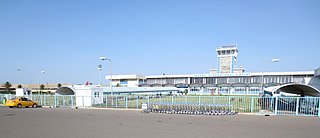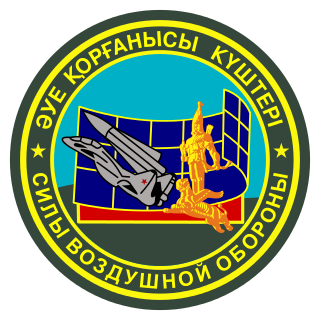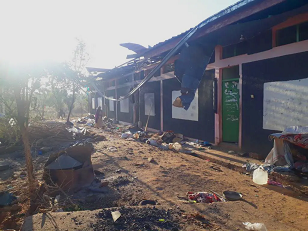
The Mikoyan-Gurevich MiG-23 is a variable-geometry fighter aircraft, designed by the Mikoyan-Gurevich design bureau in the Soviet Union. It is a third-generation jet fighter, alongside similar Soviet aircraft such as the Su-17 "Fitter". It was the first Soviet fighter to field a look-down/shoot-down radar, the RP-23 Sapfir, and one of the first to be armed with beyond-visual-range missiles. Production started in 1969 and reached large numbers with over 5,000 aircraft built, making it the most produced variable-sweep wing aircraft in history. The MiG-23 remains in limited service with some export customers.

The Nigerian Air Force (NAF) is the air branch of the Nigerian Armed Forces. It is the youngest branch of the Nigerian Armed Forces, established four years after the nation became independent. As at 2021, the air force is one of the largest in Africa, consisting of over 18,000 personnel. Some of its popular aircraft include the Chengdu F-7s, Dassault-Dornier Alpha Jets, JF-17 Thunder Block II, T129 Atak, Agusta Westland 109, Eurocopter EC135 and Embraer EMB 314 Super Tucano.

Massawa or Mitsiwa is a port city in the Northern Red Sea region of Eritrea, located on the Red Sea at the northern end of the Gulf of Zula beside the Dahlak Archipelago. It has been a historically important port for many centuries. Massawa has been ruled or occupied by a succession of polities during its history, including the Kingdom of Aksum, the Ethiopian Empire, the Ottoman Empire and the Kingdom of Italy.

The Eritrean–Ethiopian War, also known as the Badme War, was a major armed conflict between Ethiopia and Eritrea that took place from May 1998 to June 2000.

The Imperial Russian Air Service was an air force founded in 1912 for Imperial Russia. The Air Service operated for five years and only saw combat in World War I before being reorganized and renamed in 1917 following the Russian Revolution.

Asmara International Airport is the international airport of Asmara, the capital of Eritrea. It is the country's largest airport and the only one receiving regularly scheduled services as of 2017.

The Ethiopian Air Force (ETAF) is the air service branch of the Ethiopian National Defence Force. The ETAF is tasked with protecting the national air space, providing support to ground forces, as well as assisting civil operations during war.
The Eritrean Air Force (ERAF) is the air service branch of the Eritrean Defence Forces.

RAF Castel Benito was an airport of Tripoli created by the Italians in Italian Libya. Originally, it was a small military airport named Castel Benito, but it was enlarged in the late 1930s and was later used by the British RAF after 1943. It was called RAF Castel Benito by the Allies.

Gülüstan or Gulistan is a village in the Goranboy District of Azerbaijan. It is a part of the municipality of Buzluq.

Castel Benito was an airport of Tripoli created by the Italians in Italian Libya in the early 1930s. It was called RAF Castel Benito by the Allies after 1943.

The Kazakh Air Defense Forces is the aviation warfare branch of the Armed Forces of the Republic of Kazakhstan. Their responsibilities include protecting Kazakh airspace, as well as combat missions in support of other branches of the armed forces. The official holiday of the air forces is Aviation Day on August 18.

The Petrella Airport was the first international airport in Italian Somalia. It was opened in 1928 -just 3 miles south of Mogadishu- with the name "Enrico Petrella" in honor of an Italian pilot who died a few years before in the same airport of Italian Mogadiscio. In 1941 the airport was partially destroyed during WW2 and remained inactive for some years as a civilian airport: only military airplanes used it. In 1950 was reopened as a civilian airport by the Italian authorities of the ONU Fiduciary Mandate.
Vagif Gurbanov was a USSR Air Force officer during the First Nagorno-Karabakh War (1992) and the first military aviator of the independent Azerbaijani Armed Forces.
This timeline of the Tigray War is part of a chronology of the military engagements of the Tigray War, a civil war that began in the Tigray Region of Ethiopia in early November 2020.

In the late hours of 7 January 2022, the Ethiopian Air Force (ETAF) carried out an airstrike on a camp for internally displaced persons (IDP) set up in Dedebit Elementary School, located in the Tigray Region of Ethiopia. Between 56 and 59 people were killed in the attack, and at least 30 others were left injured.
The Group of Russian military specialists in Ethiopia is a contingent of military advisers to the Armed Forces of the Russian Federation and mercenaries to the Ethiopian National Defense Force. Russian servicemen provided significant assistance to the country during the Eritrean–Ethiopian War. It is noteworthy that the opposing side used the services of military specialists from Ukraine.
Group of Ukrainian military specialists in Eritrea is a contingent of military advisers to the Armed Forces of Ukraine and mercenaries to the Eritrean Defence Forces. Ukrainian servicemen provided significant assistance to the country during the Ethiopian-Eritrean War. It is noteworthy that the opposing side used the services of military specialists from Russia.
In February 1999, three clashes occurred between the aviation of Ethiopia and Eritrea. The events were part of the Badme War. During the clashes, Ethiopian Su-27s fought against Eritrean MiG-29s. There is a possibility that pilots from the former USSR participated in the battles, though this has been strongly disputed by local sources. In all skirmishes, the Ethiopians won, gaining complete air supremacy for the rest of the war.
On 6 May 1998,Ethiopia launched an offensive into neighbouring Eritrea, marking the beginning of the Eritrean–Ethiopian War. The attack was declared illegal by an international commission in The Hague.












